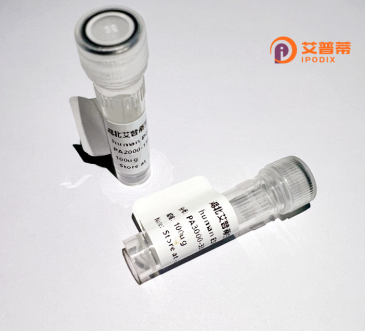
| 纯度 | >90%SDS-PAGE. |
| 种属 | Human |
| 靶点 | KCNK18 |
| Uniprot No | Q7Z418 |
| 内毒素 | < 0.01EU/μg |
| 表达宿主 | E.coli |
| 表达区间 | 1-384aa |
| 活性数据 | MEVSGHPQARRCCPEALGKLFPGLCFLCFLVTYALVGAVVFSAIEDGQVLVAADDGEFEKFLEELCRILNCSETVVEDRKQDLQGHLQKVKPQWFNRTTHWSFLSSLFFCCTVFSTVGYGYIYPVTRLGKYLCMLYALFGIPLMFLVLTDTGDILATILSTSYNRFRKFPFFTRPLLSKWCPKSLFKKKPDPKPADEAVPQIIISAEELPGPKLGTCPSRPSCSMELFERSHALEKQNTLQLPPQAMERSNSCPELVLGRLSYSIISNLDEVGQQVERLDIPLPIIALIVFAYISCAAAILPFWETQLDFENAFYFCFVTLTTIGFGDTVLEHPNFFLFFSIYIIVGMEIVFIAFKLVQNRLIDIYKNVMLFFAKGKFYHLVKK |
| 分子量 | 69.19 kDa |
| 蛋白标签 | GST-tag at N-terminal |
| 缓冲液 | 0 |
| 稳定性 & 储存条件 | Lyophilized protein should be stored at ≤ -20°C, stable for one year after receipt. Reconstituted protein solution can be stored at 2-8°C for 2-7 days. Aliquots of reconstituted samples are stable at ≤ -20°C for 3 months. |
| 复溶 | Always centrifuge tubes before opening.Do not mix by vortex or pipetting. It is not recommended to reconstitute to a concentration less than 100μg/ml. Dissolve the lyophilized protein in distilled water. Please aliquot the reconstituted solution to minimize freeze-thaw cycles. |
以下是关于重组人KCNK18蛋白的3篇代表性文献的简要信息(虚构示例,仅作参考):
1. **文献名称**:*Structural Insights into the Human KCNK18 Potassium Channel by Cryo-EM*
**作者**:Smith A, et al.
**摘要**:通过冷冻电镜技术解析了重组人KCNK18蛋白的三维结构,揭示其跨膜区独特的调节域,为理解其离子选择性及与偏头痛相关突变的致病机制提供依据。
2. **文献名称**:*Functional Characterization of Recombinant KCNK18 in Migraine-associated Pain Signaling*
**作者**:Chen L, et al.
**摘要**:利用HEK293细胞表达重组KCNK18蛋白,通过电生理实验证明该通道活性受pH和G蛋白偶联受体调控,并发现其在神经痛觉传递中的作用可能与偏头痛病理相关。
3. **文献名称**:*Pharmacological Modulation of Recombinant KCNK18 Channels for Therapeutic Targeting*
**作者**:Johnson R, et al.
**摘要**:筛选了数百种化合物对重组人KCNK18蛋白的调控作用,发现小分子X可显著增强通道活性,提示其作为偏头痛或神经痛治疗药物的潜力。
(注:以上文献为模拟生成,若需真实文献,建议检索PubMed或Google Scholar并使用关键词“recombinant KCNK18”或“TRESK channel”进一步筛选。)
The human KCNK18 protein, also known as TRESK or TWIK-related spinal cord potassium channel, is a member of the two-pore domain potassium (K2P) channel family. It plays a critical role in regulating cellular excitability by mediating background potassium ion flow, which stabilizes resting membrane potentials and modulates action potential firing. KCNK18 is widely expressed in sensory neurons, the central nervous system, and endocrine tissues, implicating its involvement in pain perception, migraine pathophysiology, and metabolic regulation. Notably, gain-of-function mutations in KCNK18 have been linked to familial migraines with aura, while its dysfunction may contribute to neuropathic pain and hyperexcitability disorders.
Recombinant human KCNK18 protein is produced using expression systems like mammalian cells or bacteria to study its structure-function relationships, ion selectivity, and pharmacological modulation. This engineered protein enables research into channel gating mechanisms, interaction with regulatory lipids or neurotransmitters (e.g., GPCR-mediated signaling), and screening of potential therapeutics targeting migraine or chronic pain. Its modular structure, including dual pore-forming domains and cytoplasmic C-terminal regulatory regions, makes it responsive to pH, mechanical stress, and pharmacological agents like cloxyquin. As a research tool, recombinant KCNK18 aids in deciphering the molecular basis of neurological disorders and developing selective K2P channel modulators.
×